 It is a testament to how far Brooklyn has come, this wedge of land between Flatbush Avenue, Fourth Avenue, and Pacific Street, known as Site 5 of the Atlantic Terminal Urban Renewal Area (ATURA).
It is a testament to how far Brooklyn has come, this wedge of land between Flatbush Avenue, Fourth Avenue, and Pacific Street, known as Site 5 of the Atlantic Terminal Urban Renewal Area (ATURA).Now, in one tiny (.12-acre) triangle within the wedge, it houses the Brooklyn Bear’s Garden, a human-engineered patch of nature, growing peaches and tomatoes, flowers and herbs. Boston ivy climbs the 27-foot cinderblock wall of the adjacent Modell’s store, even wrapping its way around the Pacific Street side.
 Another big box store, P.C. Richard, sits at the fat end of the wedge, sharing a parking lot with Modell’s. And looming in the future, replacing those structures, would be a 350-tower, a central element of Forest City Ratner’s Atlantic Yards plan.
Another big box store, P.C. Richard, sits at the fat end of the wedge, sharing a parking lot with Modell’s. And looming in the future, replacing those structures, would be a 350-tower, a central element of Forest City Ratner’s Atlantic Yards plan. The project would exclude the garden, but the garden hardly fits the plan. As the Empire State Development Corporation states, in bureaucratic but assertive language in the General Project Plan:
 Two parcels of land, Site 5 and the western-most portion of the Arena Block… present the most significant potential for mixed use and commercial development due to their location on the two major commercial arteries…and their ability to connect directly to the Atlantic Terminal subway station…. This location is a very prominent and unique terminus, well suited for high density development with an emphasis on superior architecture and urban design.
Two parcels of land, Site 5 and the western-most portion of the Arena Block… present the most significant potential for mixed use and commercial development due to their location on the two major commercial arteries…and their ability to connect directly to the Atlantic Terminal subway station…. This location is a very prominent and unique terminus, well suited for high density development with an emphasis on superior architecture and urban design.Both parcels are significantly underutilized. Site 5 contains two one-story retail buildings and a parking lot. Blank walls with no glazing and few breaks or entrances abut four public streets.
Site 5 history
 Such current underutilization actually represents progress, since the site stagnated when the city took it over in 1969. A quarter-century ago, the triangle was a gravel-top parking lot for the Brooklyn Academy of Music (BAM), an ad hoc use after the plot was cleared for urban renewal. By the 1980s, the bordering Pacific Street strip was a haven for drug dealers and hookers, often servicing workers at the Daily News printing plan down the block. Abandoned buildings were handy for a quickie.
Such current underutilization actually represents progress, since the site stagnated when the city took it over in 1969. A quarter-century ago, the triangle was a gravel-top parking lot for the Brooklyn Academy of Music (BAM), an ad hoc use after the plot was cleared for urban renewal. By the 1980s, the bordering Pacific Street strip was a haven for drug dealers and hookers, often servicing workers at the Daily News printing plan down the block. Abandoned buildings were handy for a quickie. In 1982, neighborhood activists, disgusted by the brownstone rubble in the lot, began clearing it, with BAM’s consent, for a community garden, one that’s won citywide recognition. The name, Brooklyn Bear’s, came from a teddy bear found among the debris. “That’s when this neighborhood was truly blighted,” garden coordinator Jon Crow asserts.
Longtime Pacific Street resident Jim Vogel attributes the block’s improvement to several factors, including general economic growth, the purchase and renovation of buildings, and the slowing of prostitution after the closing of the Daily News plant and the advent of AIDS. “But it's very accurate to say that without the garden, Pacific Street today wouldn't be nearly as charming and successful as it is,” said Vogel, who is also secretary of the Council of Brooklyn Neighborhoods. It's a testament to what local folks can do when the big money planners stay out of the way.”
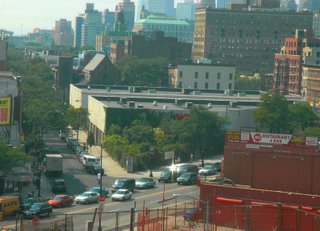 By the mid-1990s, FCR began construction on the Atlantic Center mall just across Flatbush (and Atlantic Avenue), on another long-empty lot within ATURA. FCR also looked across the street and, in March 1997, acquired the triangular lot from the city for the negotiated price of just $1,470,000, without bid or auction.
By the mid-1990s, FCR began construction on the Atlantic Center mall just across Flatbush (and Atlantic Avenue), on another long-empty lot within ATURA. FCR also looked across the street and, in March 1997, acquired the triangular lot from the city for the negotiated price of just $1,470,000, without bid or auction.(The photo, which shows traffic on Flatbush Avenue in front of the garden, was taken from Pacific Street in the proposed project footprint by Daniel Goldstein of Develop Don't Destroy Brooklyn, a Bear's Garden member.)
Even before that, according to a chronology provided by Bear’s coordinator Jon Crow, FCR plowed through the garden fence to conduct drilling test, a first warning of future development. It was winter, but several vegetable boxes were run over.
The city retained development rights beyond the elevations of the planned buildings. (When did Forest City Ratner get those additional rights, some 308,000 square feet? At the same time it gained a transfer of 328,272 square feet from the Atlantic Center mall? I haven’t found out yet.) The duly noticed public hearing generated no testimony, and the city’s daily newspapers covered the land transfer only in light of threats to the garden.
 Garden under threat
Garden under threatWould the 7500-square-foot garden be expunged? Bear’s stalwarts feared as such, and gathered 4000 signatures during the winter for a banner hung from the garden fence. Gardener Suzanne Chambers told the Daily News in March 1997 that the garden served its community broadly: "We're a botanic garden, we're a park, we're a nature center, we're a safe haven, we're a performance space, we're a community center.” (At right, poster from the Bear's Garden anniversary celebration in May.)
Borough President Howard Golden negotiated a compromise, allotting $250,000 to preserve the garden, and convincing Forest City Ratner to scale back its development plan by 5000 square feet, allowing for a smaller garden. In a letter to garden-supporters, Golden called the garden the “gateway to Downtown Brooklyn.”
The garden was entirely uprooted, as the site served in part as a staging area for construction. Gardeners removed some 5000 bulbs, shrubs and perennials, but a grove of 30-foot white birch trees couldn’t be moved and met their demise.
The process went slowly. As Crow wrote in a 10/9/97 letter to the Times, “We dutifully abandoned our garden early last spring, working in often inclement weather, to fulfill our part of an agreement meant to preserve a smaller, permanent space for the Bears at the same site. It wasn't until late September that construction actually began. You can imagine how sad it was to be treated like unwanted trespassers on the very land we nurtured for more than 15 years.”
Garden reestablished
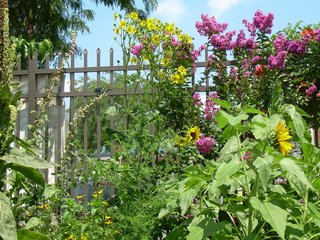 Several months later, the garden was reestablished, albeit on a smaller footprint, the former 4’x8’ plots halved in length. Tussles with FCR continued. The developer promised that the garden would be restored with three feet of clean fill and two feet of topsoil, but only after several complaints was the garden restored in part. Golden’s letter promised a wrought-iron fence, but only an aluminum version arrived.
Several months later, the garden was reestablished, albeit on a smaller footprint, the former 4’x8’ plots halved in length. Tussles with FCR continued. The developer promised that the garden would be restored with three feet of clean fill and two feet of topsoil, but only after several complaints was the garden restored in part. Golden’s letter promised a wrought-iron fence, but only an aluminum version arrived.The big box stores, with anti-urban blank walls, were by design placeholders, “taxpayers” in the architects’ parlance, built to generate revenue before being replaced. The Atlantic Yards plan would not encompass the garden, now deeded to the Trust for Public Lands, but it would extend Downtown Brooklyn into neighborhood Brooklyn, notably across Flatbush Avenue on Pacific and Dean streets.
 And Pacific Street between Fourth and Flatbush avenues, reinvigorated over the past decades, would be under new stress. Serving the mixed-use tower planned for the site, a 400-space parking garage would have a midblock entrance, and the residential (on one side) street would experience new much new traffic, as the plan proposes that northbound traffic on Fourth Avenue be diverted via Pacific Street to Flatbush Avenue. “We fought hard for traffic calming,” Crow says of the changes negotiated years ago—no left turns off Flatbush allowed. [Update: This corrects an earlier version that said Pacific would be two-way. Image from 8/19/06 Brooklyn Papers.]
And Pacific Street between Fourth and Flatbush avenues, reinvigorated over the past decades, would be under new stress. Serving the mixed-use tower planned for the site, a 400-space parking garage would have a midblock entrance, and the residential (on one side) street would experience new much new traffic, as the plan proposes that northbound traffic on Fourth Avenue be diverted via Pacific Street to Flatbush Avenue. “We fought hard for traffic calming,” Crow says of the changes negotiated years ago—no left turns off Flatbush allowed. [Update: This corrects an earlier version that said Pacific would be two-way. Image from 8/19/06 Brooklyn Papers.] Add the arena, and the “Miss Brooklyn” tower planned across Flatbush, and residents worry about noise and shadows and arena crowds, an exponential change on top of the current bustle, which includes the Atlantic Terminal mall and Bank of New York tower across Atlantic Avenue (right).
Add the arena, and the “Miss Brooklyn” tower planned across Flatbush, and residents worry about noise and shadows and arena crowds, an exponential change on top of the current bustle, which includes the Atlantic Terminal mall and Bank of New York tower across Atlantic Avenue (right).I sat in the garden on a recent Sunday with Crow, with the iconic Williamsburgh Savings Bank in the background, and the honking of cars and the rumbling of buses hardly muffled. We were surrounded by green, with sunflowers peppering the scene.
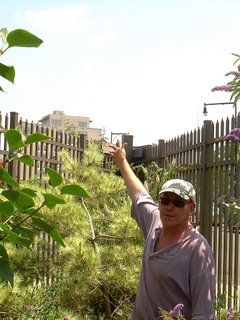 Behind him, a compost bucket was inspected by a garden volunteer. A mom brought her son to help with their plot. Looking east, along Pacific Street, the eight-story Atlantic Arts building is visible. But Frank Gehry’s iconic “Miss Brooklyn” would be closer--and eight times taller.
Behind him, a compost bucket was inspected by a garden volunteer. A mom brought her son to help with their plot. Looking east, along Pacific Street, the eight-story Atlantic Arts building is visible. But Frank Gehry’s iconic “Miss Brooklyn” would be closer--and eight times taller.“It’s always been nasty and loud,” Crow said of the crossroads. “It needed calming.” But calming would be even more of a challenge. He has joined the vocal opposition to the Atlantic Yards project.
Shadows on the green
The lot sits in shadow, literally and figuratively, of the Atlantic Yards project. The 620-foot (650-foot, with mechanicals) Miss Brooklyn would stand diagonally across the street and deny sun to the garden until at least 11 a.m. May through August, prime growing season, according to the the Shadows chapter of the Draft Environmental Impact Statement (DEIS) from the Empire State Development Corporation (ESDC). The 350-foot building next door, on Site 5, surprisingly enough, would cast shadows for only 45 minutes at the end of the day in June.
 The Brooklyn Queens Land Trust, which includes the Bear’s garden as a member, warned the ESDC that “several high-rise buildings” on Site 5 would reduce afternoon sunlight by at least three hours a day. Only one building is planned, so perhaps the testimony overstated the impact, but expect comments challenging the DEIS’s conclusions.
The Brooklyn Queens Land Trust, which includes the Bear’s garden as a member, warned the ESDC that “several high-rise buildings” on Site 5 would reduce afternoon sunlight by at least three hours a day. Only one building is planned, so perhaps the testimony overstated the impact, but expect comments challenging the DEIS’s conclusions. Lots of noise
Building a major project is hardly a dainty process. In fact, construction of the building at Site 5 would require a 16-foot barrier, but even that wouldn’t shield the garden from noise.
The garden would face “significant adverse noise impacts during some portion of the construction period,” the DEIS acknowledges in the Unavoidable Impacts chapter, with “no feasible and practicable mitigation.”
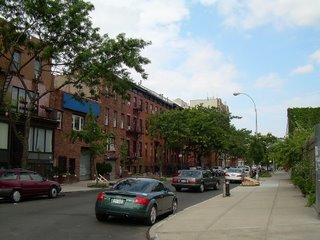 Out of context
Out of contextIf the Bear’s garden is the gateway to Downtown Brooklyn, by implication, it’s also the gateway to neighborhood Brooklyn. (Across the street: row houses.) The building on Site 5 would have a base of retail around the ground floor and then rise with a series of setbacks and angular forms, designs intended to engage the community and “activate the streetscape.”
Still, the DEIS acknowledges, in the Neighborhood Character chapter:
Although this building would relate well to Downtown Brooklyn to its north, it would be of a scale and density new to Pacific Street on its southern face. This building, its scale and the intensity of activity it would engender, would create a localized adverse impact in neighborhood character for the rowhouses along Pacific Street between Flatbush and 4th Avenues.
And, by implication but not admission, to the garden itself.
 Bright lights
Bright lightsAnd what about the bright lights? The DEIS acknowledges, in the chapter on Urban Design and Visual Resources:
It is anticipated that the proposed lighting and signage for the arena and Building 1 would be visible from some sections of the study area closest to this part of the project site, with views concentrated on Flatbush and Atlantic Avenues. Most residential areas would not have direct views of the lighting and signage. It is not anticipated that the proposed lighting and signage would result in significant adverse impacts on the study area.
In the chapter on Neighborhood Character, the DEIS acknowledges:
These changes would not come without localized adverse neighborhood character impacts in the areas closest to the project site. These include changes in character for residential rowhouses facing Site 5, within sight of the arena’s brightly lit signs.
That would obviously include the garden, but it isn’t mentioned. Crow suggests that bright lights would “stress” the garden.
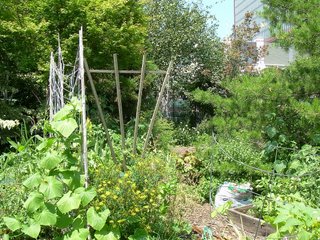 What to see
What to seeThe garden is a thriving, improbably patch of green in the urban scene. But its harmonious charms were not acknowledged in the chapter on Urban Design and Visual Resources, which states, “Currently, the project site does not include any visual resources and has a blighted character.”
Actually, the garden is not part of the project site. But the chapter on Open Space, the DEIS says of this and other gardens:
However, they do serve as important visual and passive recreational resources to the community.
Effects ignored
 In testimony regarding the Draft Scope, the Brooklyn Queens Land Trust warned that increased wind speeds at ground levels created by the new towers—witness the wind whipping around the existing Williamsburg Savings Bank—would cause significant drying at the garden. Reflective building materials would result in reflective glare and more drying. The thousands of people driving or walking past the garden before and after arena events would increase trash. But those issues were ignored.
In testimony regarding the Draft Scope, the Brooklyn Queens Land Trust warned that increased wind speeds at ground levels created by the new towers—witness the wind whipping around the existing Williamsburg Savings Bank—would cause significant drying at the garden. Reflective building materials would result in reflective glare and more drying. The thousands of people driving or walking past the garden before and after arena events would increase trash. But those issues were ignored.In their own statement to the ESDC, the Bear’s Garden said, “The development as conceived (creating a neighborhood from scratch) stands to potentially destroy our garden, open space that has been a perfect reflection of and complement to the existing—thriving—community and environs.”
Questions of roots
The garden now has about 30 active members, though, a decade ago, there were 60 members, with at least 40 active. Part of the change could be attributed to the loss of space, but also to changes in neighborhood demographics, with fewer working-class gardeners.
In January 1997, Crow told the Times: "The reality is, once you've had a garden over 10 years, and the trees are up to the sky, you establish roots—literally and figuratively.”
 The same is true today. Any development on Site 5 and across Flatbush Avenue—and some development is inevitable--might impinge on those roots.
The same is true today. Any development on Site 5 and across Flatbush Avenue—and some development is inevitable--might impinge on those roots. But as-of-right development, as opposed to the ESDC’s override of zoning, would be more limited. It’s hard to imagine a development that would impinge more. So the gardeners have put another banner on their fence.
Comments
Post a Comment